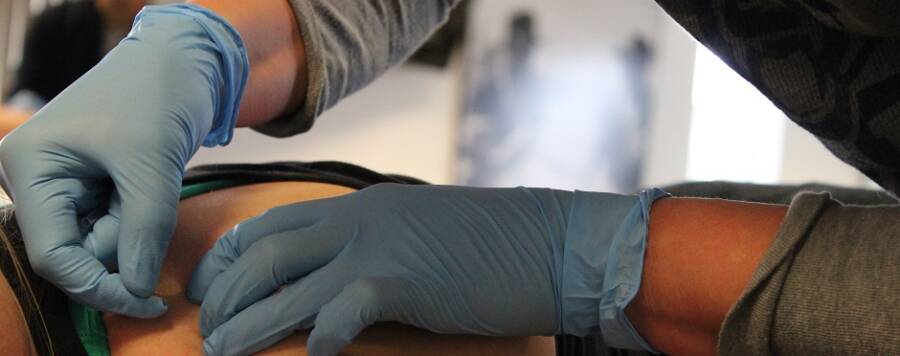This is an excellent question and needs to be explored before pursuing dry needling as a treatment option. This question could be answered by having a dry needling clinician offer you their experience with this treatment intervention. This experience is of value in understanding the effectiveness of dry needling for your specific condition, but a broader overview may also be warranted.
Another method of exploring this question would be to investigate all the published research on the topic, but honestly, who has the time to sift through the extensive research? Thankfully, a specific type of research paper, called a systematic review, can help us arrive at the answer regarding the effectiveness of dry needling.
What Are Systematic Reviews?
A systematic review is a research paper that looks at all the available studies fit into a specific research question. In other words, it’s a study designed to discover what the consensus is regarding the published literature on a specific topic. For example, we can look at systematic reviews that investigated multiple studies that researched the effectiveness of dry needling. This will allow us to review the extensive amount of literature quickly and assess the effectiveness across large populations and in multiple settings. Three different systematic reviews will help us understand the effectiveness of dry needling.
Review of the Literature
First, a 2013 systematic review looked at the effectiveness of dry needling for pain reduction of the upper quarter. This review examined 12 studies that compared dry needling vs. a sham/placebo and dry needling vs. “other treatment” at the immediate and longer-term (4 weeks) period. The study concluded that dry needling effectively reduced pain versus a sham in the intermediate and long term. 1 Our first systematic review starts to give us evidence for the effectiveness of dry needling for pain reduction of the upper body. But would that consensus be the same if we looked at more studies?
A 2015 systematic review also looked at the effectiveness of dry needling for neck and shoulder pain. This paper looked at 20 studies that compared dry needling vs. a sham/placebo, dry needling vs. injections, and dry needling vs. “other treatments.” The effectiveness was compared in short (3 days), medium (9-14 days), and long (2-6 month) term periods. This study again found evidence indicating that that dry needling was effective over the short and medium terms.2 This second review supported evidence for the effectiveness of dry needling and continues to build our confidence in this treatment method. But what about other body parts besides the neck and shoulders?
A 2021 systematic review also looked at the effectiveness of dry needling but this review explored dry needling for a wide range of musculoskeletal conditions. This paper looked at 42 studies that compared dry needling vs. sham/placebo, dry needling vs. “other treatments,” and dry needling with other therapies vs. other therapies alone. These comparisons were looked at for short (90-72 hours), medium (1-12 weeks), and long (13-24 weeks) terms. Again, the study found evidence to support the effectiveness of dry needling to reduce pain in the short, medium, and long terms. The effectiveness of dry needling was seen in multiple conditions and not just the neck and shoulders.3
How Effective is Dry Needling?
When we look at these three systematic reviews that included over 70 peer-reviewed studies published over the last decade, we can be more confident in answering how effective dry needling is. Dry needling can be an effective treatment method to reduce musculoskeletal and myofascial trigger-point pain in various body parts and conditions.
Like all treatment interventions, there is no magic pill that will fix everything and remove all pain. It’s the expertise and skill of the Athletico dry needling clinician to assess the patient’s condition, symptoms, and medical history to apply dry needling in the correct circumstances in conjuncture with other treatment interventions to ensure best outcomes. If you have questioned whether dry needling can treat your specific pain or injury, contact Athletico for a Free Assessment.
The Athletico blog is an educational resource written by Athletico employees. Athletico bloggers are licensed professionals who abide by the code of ethics outlined by their respective professional associations. The content published in blog posts represents the opinion of the individual author based on their expertise and experience. The content provided in this blog is for informational purposes only, does not constitute medical advice and should not be relied on for making personal health decisions.
References:
1. Kietrys, David M., et al. “Effectiveness of dry needling for upper-quarter myofascial pain: a systematic review and meta-analysis.” journal of orthopaedic & sports physical therapy 43.9 (2013): 620-634.
2. Liu, Lin, et al. “Effectiveness of dry needling for myofascial trigger points associated with neck and shoulder pain: a systematic review and meta-analysis.” Archives of physical medicine and rehabilitation 96.5 (2015): 944-955.
3. Sánchez-Infante, Jorge, et al. “Is Dry Needling Applied by Physical Therapists Effective for Pain in Musculoskeletal Conditions? A Systematic Review and Meta-Analysis.” Physical Therapy 101.3 (2021): pzab070.
About the Author:
Brian Whittington is a physical therapist and regional director for Athletico. Brian is particularly interested in treating knee and shoulder injuries and specializes in post-operative ACL reconstruction rehabilitation. Brian's treatment focus also includes the growing patient population dealing with chronic pain. His practice philosophy is not limited to injury recovery but includes education for injury prevention and general health and wellness. Brian's mission is simple, keeping people moving so they can live optimally healthy lives.

 width="900"
height="356"
>
width="900"
height="356"
>

1 Comment
Patricia
Your article does a great job of breaking down the effectiveness of dry needling for pain relief! It’s refreshing to see such a thorough exploration of how this technique can benefit patients, especially when combined with other treatments. The way you address both the potential advantages and considerations provides a balanced, informative perspective. Thanks for shedding light on a topic that’s often misunderstood—this will definitely help people make more informed decisions about their pain management options!